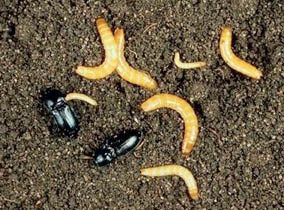Flea beetle scouting. Most fields will not require a foliar insecticide for flea beetles in addition to seed treatment, but you want to check to make sure. Begin monitoring right after emergence and through until at least the four-leaf stage. Seed treatment can be effective through most of this period, but slow-starting or slow-growing crops under intense flea beetle pressure may require an additional foliar insecticide. Before spraying, follow these 8 steps to make the right decision.
Low diamondback counts, for far. Diamondback moth adult trap counts are low across Alberta. See results here. Manitoba results have also been low. Highest counts are 25, from a trap near Steinbach, and 21 from a trap near Elm Creek. No traps in western Manitoba have had counts over 10.
Cutworms or wireworms? A few fields in the Peace River region of Alberta have higher levels of wireworms. Noticeable losses are often confined to small bare patches. Check bare patches, and especially the interface between healthy seedlings and dead patches, to confirm the reason for missing plants. It could be cutworms, wireworms, disease or something else entirely — Richardson ground squirrels, in some regions. Wireworm rarely causes economic levels of damage in canola, and even if they did, insecticides sprays can’t get them. If the damage is from cutworms, you have options.
